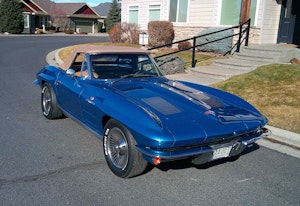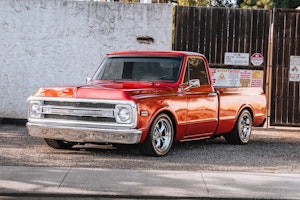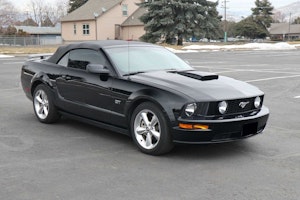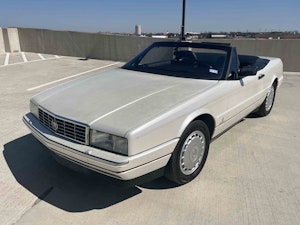Media | Articles
Coulda Had a V-12: Here Are 10 of the Most Memorable
Thanks to recent news from Aston Martin and Ferrari, the V-12 engine layout thankfully remains in production and continues to find a home in new vehicles. It’s great news, and easily put into words. Less easily described, though, is the sound of a V-12 engine—you truly need to hear one to appreciate their symphony.
Those sonorous notes, along with the silky smooth power delivery that comes with them have graced the automotive landscape for decades. In celebration of the V-12’s continued presence, we took a look back into the V-12 engine’s storied history across multiple brands to pick some of our favorites.
Packard Twelve

The Packard Twelve started life as the Packard “Twin Six,” but the second generation of Packard V-12 (1933-39) and was known for a body design worthy of a V-12 engine. Packard’s iconic grille was paired with some of the most famous coachbuilders of the era, including LeBaron and Dietrich. The Packard Twelve was indeed the flagship of Packard line, with the Super Eight, Eight, and “Junior” models like the One-Twenty, Six, and One-Ten slotting below. They were fine models with perfectly acceptable engines, but the Twelve was the one that stood out.
2008 Audi Q7 V-12 TDI

You weren’t ready for this one, were you? But it’s true, as the Volkswagen Group made a V-12 engine for the flagship Q7 utility vehicle. This was before Dieselgate came to fruition, so this turbocharged, direct injected, V-12 diesel had the potential for success.
Audi’s oil burning V-12 was used on this single vehicle from 2008-12, sporting 493 horsepower and a whopping 738 lb-ft of turbodiesel torque. While this particular Q7 never made it to the U.S., it would absolutely be one of the most amazing diesel vehicles in America, when they are legal to import in 2033, that is.
Marketplace
Buy and sell classics with confidence
Jaguar V-12

While an inline-six rests beneath the bonnet of many iconic Jaguars, it was only natural for larger, later model Jags to utilize the relaxed cadence of its V-12 motor in 5.3- or 6.0-liter displacements. Luxury cars were getting bigger and bolder, and doubling the cylinder count certainly helped with that transition.
Jag even developed a 7.0-liter example used in motorsport, but Jaguar’s V-12 was primarily notable as a top-tier luxury car powerplant during the Malaise Era, thanks to the addition of fuel injection and a High Efficiency (HE) combustion design in 1981. This smooth, relaxed engine was the perfect dance partner to a cabin fitted with decadent leather and burl wood, and its demise in 1997 was the end of an era for British motoring.
Lincoln-Zephyr V-12

Like so many other components found in Lincoln vehicles, the flathead V-12 found in 1932 model Lincolns and Zephyrs was heavily based on parent company Ford’s flathead V-8. The motor wasn’t without its flaws however, mostly present in its PCV, oiling and cooling systems. Those issues were addressed over time, however, and Lincoln’s V-12 ultimately became part of the brand’s success: Take something from Ford, modify the heck out of it, and turn it into something worthy of a luxury vehicle.
Ferrari Colombo V-12

Named after its creator, Gioacchino Colombo, this Ferrari V-12 powered some of the most famous, desirable and valuable vehicles to wear Ferrari’s prancing horse emblem. The sheer volume of changes this motor underwent over the course of its 41-year production run is impossible to cover for this list.
No matter, though: Every iteration of this all-aluminum masterpiece delivered the feel and sound of exotic performance befitting a Ferrari, from its placement in the original 1947 Ferrari 125 S, to icons like the 1962 Ferrari 250 GTO, and delightful touring cars like the final Ferrari 412i from 1988.
BMW M70

While BMW’s flagship V-12 came in four variations over the course of several decades. Perhaps the most appealing example is the M70 design that powered the E32-generation 7-series and E31 8-series. Be it a BMW 750i or 750iL, you were guaranteed one of the best performing luxury sedans on the planet. And the 850i, 850Ci, and 850CSi were grand touring coupes of the highest order, especially when optioned with a six-speed manual transmission.
But the real reason why the M70 V-12 from BMW was so special is its legacy with the McLaren F1. Its stunning 618 horsepower helped propel the F1 to an insane top speed of 240.1 mph in 1998, thanks to four-valves per cylinder, variable valve timing, and a surprising lack of forced induction. Ah, if only modern hypercars could take a page from BMW’s M70 masterpiece and ditch the turbochargers!
Cadillac V-12

Here’s an awkward twist to the overall theme of this story: While most auto manufacturers had a V-12 as their flagship, top-of-the-line, first class powerplant, this doesn’t apply to Cadillac. Their V-12 was actually one of their V-16 engines with four cylinders lopped off.
The V-12 Caddy was made from 1930-37, and “only” made 135 horsepower relative to the V-16’s rating of 165. While both were premium offerings with features like overhead valves and hidden wiring/plumbing, this V-12 rightly plays second fiddle to the Cadillac V-16.
Toyota GZ

While Japan is better known for engines with fewer pistons, the Toyota Century and its V-12 engine are the crown jewels for an entire nation. Toyota had premium-car intentions for decades, but no other brand in Japan had the nerve to equip a vehicle with a V-12 engine. Toyota did just that for their flagship Century luxury sedan in 1997. In doing so, the V-12 (codenamed 1GZ-FE) soldiered on for another 20 years, ensuring Toyota’s place in luxury car history.
Lamborghini V-12

Ferrari was slow to full embrace dual overhead camshafts for their V-12, but Lamborghini (as was their wont) chose a different path, going all in on the four-camshaft phenomenon with the V-12 in their first car, the 350 GT. The same engine family powered Lambos for decades, including the Miura and Countach, and ending its reign with the 2010 Murciélago. While modern Lambos under the watchful eye of Audi are clearly better performers with modern V-12 engines, their improvements only serve to enhance the original’s mystique. And perhaps it proves that all supercars need twelve cylinder engines, otherwise perhaps they aren’t actually that super at all?
Mercedes M275

While there are four generations of Mercedes-Benz V-12 opulence, the M275 was both twin turbocharged and impressive enough to remain in production for the latest Pagani hypercars. That’s right, even the new Pagani Utopia uses an M275 (technically an M158 derivation) to achieve forward thrust with 754 horsepower, with a manual transmission to boot.
But the M275 V-12’s zenith doesn’t necessarily point solely to the crème de la crème Pagani—there were too many fantastic automobiles that utilized this engine. The list includes Maybach luxury sedans, S/SL/CL “600” class luxury cars and their AMG tuned “65” series counterparts, the radical SL65 AMG Black Series, and even the outlandish Maybach Excelero sports car. Their torque output was legendary and impossible to match, and it’s one of the few engines that can provide EV-like thrust at low speeds with Lamborghini-like top end acceleration.
Perhaps we saved the best for last, as this motor could be considered a gold standard for which all modern luxury cars are judged by. Mercedes has made a replacement for this motor (M279), but it doesn’t do anything to tarnish the twin turbo M275’s performance potential. We can thank Pagani for that, or perhaps we should credit Mercedes for keeping the V-12’s flame alive in more ways than any other automaker possibly could.
***
Check out the Hagerty Media homepage so you don’t miss a single story, or better yet, bookmark it. To get our best stories delivered right to your inbox, subscribe to our newsletters.






















Aston Martin anybody?????
Came here to say this too.
American Iron, period. The Packard was the most durable, the Cadillac Sixteen the smoothest, and the Cadillac Twelve was incredibly strong. The Lincoln was very issue-prone, especially in overheating even with the oil issues solved. As for the Euro-12’s, finicky, troublesome, and unreliable are the words that come to mind…best to have your own tow truck handy. Oh, and sell when it’s still under warranty.
While pre-WWII flathead Cadillac V-8s remain within reach, the V-12s and V-16s are pricey, even though the V-8s have nearly as much power, and are much easier to live with, drive, and maintain.
The V12 that started it all deserves more that just a cursory name drop – the 1916-23 Packard Twin Six. A markedly different engine from the 1932 Twin Six/33-39 Twelve. Not only since it was the first production V-12, but having seen it during World War I, it inspired Enzo Ferrari to build his own when he became a manufacturer. ‘Nuff said.
That’s an old, incorrect story. Count Felice Trossi, president of Enzo Ferrari’s Alfa-Romeo racing team, Scuderia Ferrari, from 1932-on, long familiar with Alfas, Bugattis, and supercharged S series Mercedes, was taken with Packard’s new Twelve in 1932. The learned and always accurate Griff Borgeson, editor of Motor Trend in the 1950s, longtime contributor to Road & Track:
“The combination of marvelous performance, along with safety, luxury, and comfort brought about Trossi’s enduring conversion to that marque and model. He began collecting them, buying at least two or three a year,” each custom body more lavish than the last.
The count commuted the 171 miles separating his Biella home from Scuderia Ferrari in Modena in these Packard Twelves; “the bravura with which he drove them is the stuff of legend.” These later Packard Twelves of the ‘30s are what inspired Enzo Ferrari. But Packard remained a potential competitor in the international market into the ’50s, according to Borgeson, so it wouldn’t do for “Ferrari to acknowledge his relatively recent indebtedness to that illustrious American marque. Hence the legend of American generals and the Baronessa Avanzo and their vintage WWI Twin Sixes.”
You can’t have the greatest v12 without including the Allison v12 that won the sky in WW2.
So – if you are building / hot rodding a V-12 for an engine swap, which V-12 is the most “compliant” (ie: relatively user-friendly for the advanced DIY’r)?
I like the Eagle Weslake V12 but more so the Packard built Merlin and its more powerful brother the RR Griffin which is still used in air racing and hydroplane racing. The Allision V1710 series E was good for up to 2830hp and other sources often site engines with up to 3500hp for racing use. A bit too large for your typical sports or luxury car, but you did ask what our favorite V12’s were.
RE: The Rolls Royce Griffon
I had a friend who spent 26 years in the RAF and was once assigned to the Griffon-powered Avro Shackleton. He said they had a rhyme that went:
When you’re flying your Shackleton and a MIG gets on your tail
Don’t get your British blood in a boil
Don’t hesitate – slam the throttles to the gate
And drown the bastard in oil!
What, not even an honorable mention of the Lampredi V-12 that replaced the smaller-displacement Colombo masterpiece in later Ferraris?
Were those same V-12 Packard engines used in WWII PT boats?
The PT boats didn’t run Packard Merlins. They ran modern (for the time) versions of the WWI “Liberty” engines. Some were tested with Allisons as well.
Left out is the Franklin AIR-COOLED V-12, a remarkable feat of engineering.
It has fewer parts than others, ie: no radiator, water pump, hoses, etc. therefore it weights less.
A Franklin V-12 sedan resides at the Franklin Collection at the Gilmore Classic Car Museum and is regularly driven at events there.
The V-12 Caddy, without a doubt.
After I “went too fast” I let my comment sit, so i didn’t upset the “Typing Police”. Sorry for being a long time Insurance customer and new drivers club member.
What about WO Bentley’s master piece, the V12 in the Lagonda.
Consider the best engine in the world at the time.
Anyone care to comment re: Bentley’s latest 135 degree sorta v12
The Muira. In the Alps. Matt Munro on the radio. No gangsters.
Packard 12, what a beautiful car !